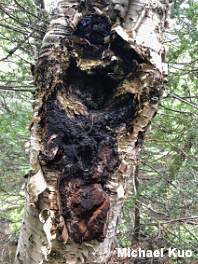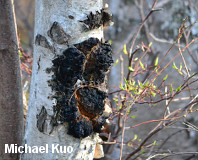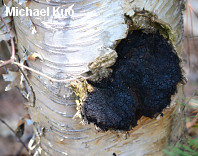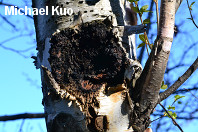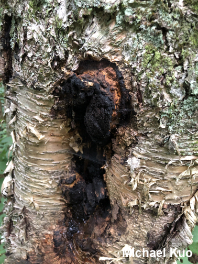| Major Groups > Polypores > Inonotus obliquus |

|
Inonotus obliquus [ Basidiomycota > Hymenochaetales > Hymenochaetaceae > Inonotus . . . ] by Michael Kuo Yuck. This unattractive fungus is a parasite on paper birch and other birch species throughout northern North America. Inonotus obliquus is usually found on standing trees, looking like a large lump of blackened, crusty material, reminiscent of charcoal, thrusting itself through the tree's bark. This stage of the fungus, which is described and illustrated here, is asexual (officially it's called a "sclerotium"); the later, sexual stage of Inonotus obliquus appears after the death of the tree, underneath the bark, appearing like a spreading patch of whitish-then-brown, poroid material. The sexual stage is rarely seen, since it occurs under the bark. Regarding the putative "medicinal" properties of this mushroom: I am sorry to put it this bluntly, but this mushroom is not going to cure your cancer, nor any other ailment you may have—and if someone has sold you a product based on the assumption that it will, you have purchased some snake oil from a witting or unwitting charlatan. The only health benefits associated with consuming Inonotus obliquus result from the exercise involved with hunting for it in the woods. There is no legitimate scientific support for the idea that mushrooms are medicinal in any specific, eat-them-to-get-better way. None. There is only pseudoscience, bad science reporting in the mainstream news media, and very wishful science reporting in the alternative health media. For further information, see Nicholas Money's "Are mushrooms medicinal?" (2016). Description: Ecology: Parasitic on paper birch, yellow birch, and other birch species (also reported on alder); after the death of the tree, becoming saprobic; causing a white rot; found year-round, but growing in summer and fall; widely distributed in northern North America, throughout the range of the host trees. The illustrated and described collections are from Michigan and North Carolina. Fruiting Body (Sclerotium): Up to 30 cm across and 30 cm high; irregular in outline; erupting through the bark and creating a mass that protrudes 2–5 cm at first but becomes concave over time; surface black, hard, and broken into charcoal-like cubes; dry; exposed flesh orange-brown. Flesh: Tough; woody; bright orange-brown. Chemical Reactions: KOH instantly black on flesh. Microscopic Features: Hyphal system monomitic; hyphae 2.5–5 µm wide, moderately thick-walled, brown in KOH, smooth. Clamp connections not found. Microscopic features of the sexual stage, which I have not studied, are reported to include short, fusiform setae and ellipsoid spores measuring 8–10 x 5–7.5 µm. REFERENCES: (Acharius ex. Persoon, 1801) Pilát, 1942. (Fries, 1821; Saccardo, 1888; Breitenbach & Kränzlin, 1986; Gilbertson & Ryvarden, 1986; Phillips, 1991/2005; Lincoff, 1992; McNeil, 2006.) Herb. Kuo 05241406, 05251401. This site contains no information about the edibility or toxicity of mushrooms. |
© MushroomExpert.Com |
|
Cite this page as: Kuo, M. (2020, July). Inonotus obliquus. Retrieved from the MushroomExpert.Com Web site: http://www.mushroomexpert.com/inonotus_obliquus.html |
